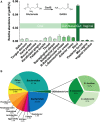GABA-producing Bifidobacterium dentium modulates visceral sensitivity in the intestine
- PMID: 27458085
- PMCID: PMC5195897
- DOI: 10.1111/nmo.12904
GABA-producing Bifidobacterium dentium modulates visceral sensitivity in the intestine
Abstract
Background: Recurrent abdominal pain is a common and costly health-care problem attributed, in part, to visceral hypersensitivity. Increasing evidence suggests that gut bacteria contribute to abdominal pain perception by modulating the microbiome-gut-brain axis. However, specific microbial signals remain poorly defined. γ-aminobutyric acid (GABA) is a principal inhibitory neurotransmitter and a key regulator of abdominal and central pain perception from peripheral afferent neurons. Although gut bacteria are reported to produce GABA, it is not known whether the microbial-derived neurotransmitter modulates abdominal pain.
Methods: To investigate the potential analgesic effects of microbial GABA, we performed daily oral administration of a specific Bifidobacterium strain (B. dentiumATCC 27678) in a rat fecal retention model of visceral hypersensitivity, and subsequently evaluated pain responses.
Key results: We demonstrate that commensal Bifidobacterium dentium produces GABA via enzymatic decarboxylation of glutamate by GadB. Daily oral administration of this specific Bifidobacterium (but not a gadB deficient) strain modulated sensory neuron activity in a rat fecal retention model of visceral hypersensitivity.
Conclusions & inferences: The functional significance of microbial-derived GABA was demonstrated by gadB-dependent desensitization of colonic afferents in a murine model of visceral hypersensitivity. Visceral pain modulation represents another potential health benefit attributed to bifidobacteria and other GABA-producing species of the intestinal microbiome. Targeting GABAergic signals along this microbiome-gut-brain axis represents a new approach for the treatment of abdominal pain.
Keywords: Bifidobacterium; GABA; brain gut axis; microbiome; neuromodulation.
© 2016 The Authors. Neurogastroenterology & Motility Published by John Wiley & Sons Ltd.
Figures




Similar articles
-
GABA production and structure of gadB/gadC genes in Lactobacillus and Bifidobacterium strains from human microbiota.Anaerobe. 2016 Dec;42:197-204. doi: 10.1016/j.anaerobe.2016.10.011. Epub 2016 Oct 26. Anaerobe. 2016. PMID: 27794467
-
Berberine alleviates visceral hypersensitivity in rats by altering gut microbiome and suppressing spinal microglial activation.Acta Pharmacol Sin. 2021 Nov;42(11):1821-1833. doi: 10.1038/s41401-020-00601-4. Epub 2021 Feb 8. Acta Pharmacol Sin. 2021. PMID: 33558654 Free PMC article.
-
Neurotransmitter Profiles Are Altered in the Gut and Brain of Mice Mono-Associated with Bifidobacterium dentium.Biomolecules. 2021 Jul 23;11(8):1091. doi: 10.3390/biom11081091. Biomolecules. 2021. PMID: 34439760 Free PMC article.
-
The Role of the Gastrointestinal Microbiota in Visceral Pain.Handb Exp Pharmacol. 2017;239:269-287. doi: 10.1007/164_2016_115. Handb Exp Pharmacol. 2017. PMID: 28035535 Review.
-
Psychoneuroimmunological approach to gastrointestinal related pain.Scand J Pain. 2017 Oct;17:431-443. doi: 10.1016/j.sjpain.2017.10.010. Epub 2017 Nov 6. Scand J Pain. 2017. PMID: 29122501 Review.
Cited by
-
A complete guide to human microbiomes: Body niches, transmission, development, dysbiosis, and restoration.Front Syst Biol. 2022;2:951403. doi: 10.3389/fsysb.2022.951403. Epub 2022 Jul 22. Front Syst Biol. 2022. PMID: 38993286 Free PMC article.
-
Metagenomics-based inference of microbial metabolism towards neuroactive amino acids and the response to antibiotics in piglet colon.Amino Acids. 2023 Oct;55(10):1333-1347. doi: 10.1007/s00726-023-03311-3. Epub 2023 Aug 15. Amino Acids. 2023. PMID: 37581868
-
Genetic Factors and the Intestinal Microbiome Guide Development of Microbe-Based Therapies for Inflammatory Bowel Diseases.Gastroenterology. 2019 Jun;156(8):2174-2189. doi: 10.1053/j.gastro.2019.03.017. Epub 2019 Mar 14. Gastroenterology. 2019. PMID: 30880022 Free PMC article. Review.
-
The emerging role of exosomes in communication between the periphery and the central nervous system.MedComm (2020). 2023 Oct 30;4(6):e410. doi: 10.1002/mco2.410. eCollection 2023 Dec. MedComm (2020). 2023. PMID: 37916034 Free PMC article. Review.
-
Schizophrenia, the gut microbiota, and new opportunities from optogenetic manipulations of the gut-brain axis.Behav Brain Funct. 2021 Jun 22;17(1):7. doi: 10.1186/s12993-021-00180-2. Behav Brain Funct. 2021. PMID: 34158061 Free PMC article. Review.
References
-
- Bercik P, Collins SM, Verdu EF. Microbes and the gut‐brain axis. Neurogastroenterol Motil. 2012;24:405–413. - PubMed
-
- Reid G. Neuroactive probiotics. BioEssays. 2011;33:562. - PubMed
-
- Lyte M. Probiotics function mechanistically as delivery vehicles for neuroactive compounds: microbial endocrinology in the design and use of probiotics. BioEssays. 2011;33:574–581. - PubMed
-
- Cryan JF, Dinan TG. Mind‐altering microorganisms: the impact of the gut microbiota on brain and behaviour. Nat Rev Neurosci. 2012;13:701–712. - PubMed
MeSH terms
Substances
Associated data
- Actions
Grants and funding
LinkOut - more resources
Full Text Sources
Other Literature Sources
Medical

